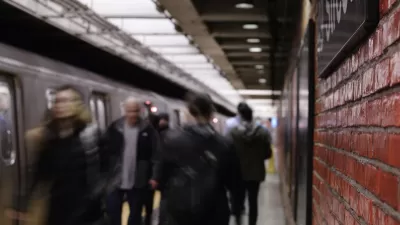In a trial run starting in December, monitors in one New York City subway station will display the exact location of every train on the line, giving riders a more accurate idea about how long they'll have to wait for the next train.
"Beginning in December, officials will install a computer screen at each end of the platform showing a graphic representation of the entire L line and the location of every train on it. Waiting passengers can watch the trains move along the tracks as the data is updated every 15 seconds. That way, passengers can see for themselves if there really is another train 'right behind this one.'"
"If the system works, and riders like it, it could be installed in other stations on the L line, said Greg Lombardi, the line's general manager, who helped create the system. Ultimately it could be used on other lines as well."
"Mr. Lombardi said the system might also be able to point straphangers to the least crowded cars on a train, using information from onboard sensors that monitor the weight of each car."
"The screens at the Myrtle-Wyckoff station will complement a system that has been in place on the L line for more than a year, using electronic signs and announcements to tell passengers approximately how many minutes they will have to wait for the next train to arrive."
Thanks to Streetsblog
FULL STORY: Maybe There Is Another Train Right Behind

Manufactured Crisis: Losing the Nation’s Largest Source of Unsubsidized Affordable Housing
Manufactured housing communities have long been an affordable housing option for millions of people living in the U.S., but that affordability is disappearing rapidly. How did we get here?

Americans May Be Stuck — But Why?
Americans are moving a lot less than they once did, and that is a problem. While Yoni Applebaum, in his highly-publicized article Stuck, gets the reasons badly wrong, it's still important to ask: why are we moving so much less than before?

Research Shows More Roads = More Driving
A national study shows, once again, that increasing road supply induces additional vehicle travel, particularly over the long run.

Judge Halts Enforcement of Anti-Homeless Laws in Grants Pass
The Oregon city will be barred from enforcing two ordinances that prosecute unhoused residents until it increases capacity and accessibility at designated camping sites.

Advancing Sustainability in Los Angeles County Schools
The Los Angeles County Office of Education’s Green Schools Symposium brings together educators, students, and experts to advance sustainability in schools through innovative design, climate resilience strategies, and collaborative learning.

Using Old Oil and Gas Wells for Green Energy Storage
Penn State researchers have found that repurposing abandoned oil and gas wells for geothermal-assisted compressed-air energy storage can boost efficiency, reduce environmental risks, and support clean energy and job transitions.
Urban Design for Planners 1: Software Tools
This six-course series explores essential urban design concepts using open source software and equips planners with the tools they need to participate fully in the urban design process.
Planning for Universal Design
Learn the tools for implementing Universal Design in planning regulations.
City of Moreno Valley
Institute for Housing and Urban Development Studies (IHS)
City of Grandview
Harvard GSD Executive Education
NYU Wagner Graduate School of Public Service
City of Cambridge, Maryland
Newport County Development Council: Connect Greater Newport





























